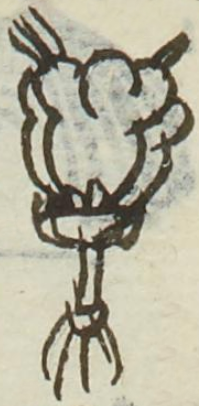Ce Xochitl (MH663r)
This black-line drawing of the simplex glyph plus notation for the personal name Ce Xochitl (“One Flower” or “1-Flower”) is attested here as a man’s name. The glyph shows a frontal view of a flower (or group of flowers, because of the extra petals seemingly behind the main flower) with a stem and roots. Coming out of the top of the flower, on the viewer’s right, seems to be a black marker for the number one. On the top of the flower at the left may be a group of four stamens or pistils. This is a calendrical name from the tonalpohualli, the religious divinatory calendar that parents often consulted when naming their offspring. Xochitl is a day name, and here it is paired with the number one, a fact that is reinforced by the gloss.
Stephanie Wood
The number one in calendrical names is sometimes omitted, perhaps presuming just having the day sign by itself suggests “one” (see below). But here, as in the other two Ce Xochitl examples, below, the notation is given. Originally, the number one was shown as a small circle.
Stephanie Wood
1560
Jeff Haskett-Wood
números, nombres de días, flores, calendarios, nombres de hombres

ce, one, https://nahuatl.wired-humanities.org/content/ce
xochi(tl), flower, https://nahuatl.wired-humanities.org/content/xochitl
Uno Flor, o 1-Flor
Stephanie Wood
Matrícula de Huexotzinco, folio 663r, World Digital Library, https://www.loc.gov/resource/gdcwdl.wdl_15282/?sp=406&st=image.
This manuscript is hosted by the Library of Congress and the World Digital Library; used here with the Creative Commons, “Attribution-NonCommercial-ShareAlike 3.0 License” (CC-BY-NC-SAq 3.0).









